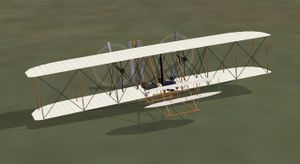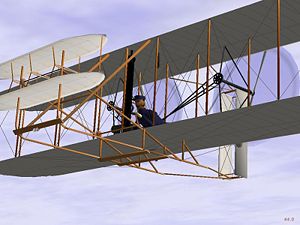Wright Flyer
 | |
|---|---|
 The Wright Flyer on the ground. | |
| Type | First airplane, Experimental aircraft |
| Configuration | Biplane aircraft, Canard aircraft |
| Propulsion | Propeller aircraft |
| Manufacturer | Wright brothers |
| Author(s) |
|
| FDM | UIUC, JSBSim |
| --aircraft= |
wrightFlyer1903 wrightFlyer1903-jsbsim |
| Status | Production |
| Development | |
| Website |
|
| Repository |
|
| Download |
|
| License | GPLv2+ |
|
| |
The Wright Flyer (often retrospectively referred to as Flyer I or 1903 Flyer) was the first successful heavier-than-air powered aircraft. It was designed and built by the Wright brothers. They flew it four times on December 17, 1903, near Kill Devil Hills, about four miles south of Kitty Hawk, North Carolina, US. Today, the airplane is exhibited in the National Air and Space Museum in Washington D.C.
The U.S. Smithsonian Institution describes the aircraft as "...the first powered, heavier-than-air machine to achieve controlled, sustained flight with a pilot aboard." The Fédération Aéronautique Internationale described the 1903 flight during the 100th anniversary in 2003 as "the first sustained and controlled heavier-than-air powered flight."
The original UIUC flight dynamics model was developed by Prof Michael S. Selig of the University of Illinois at Urbana–Champaign. The 3D model was originally from Microsoft Flight Simulator, but was substantially reworked, enhanced, and animated by Jim Wilson of the FlightGear project. The Wright Flyer for FlightGear has both a UIUC and a JSBSim FDM.
Aircraft help
Watch your speed carefully — if you try to climb too fast your speed will drop below 20 mph and you will stall and crash. Keep your airspeed just above 20 mph at the lowest.
Takeoff
Stall speed is about 18 mph. Minimum takeoff speed is 20 mph. Preferred takeoff speed is 25 mph.
To take off, put throttle to full. Wait until you have reached 25 mph (suggest pressing h to display the HUD with elevation information and speed). Gently ease the stick back until you are just climbing. Watch your airspeed to see that it never drops below 20 mph. Climb at no more than 3-4 degrees of pitch.
Flight
The Wright Flyer has a very limited flight envelope. The engine is just powerful enough to keep the craft at just above stall speed. That means you have to be very attentive at all times to keep the climb rate moderated so that the speed does not drop below 20 mph. If the speed drops below about 18 mph, you will stall. The procedure in this case is to pitch down to regain speed. If you pull up too hard and stall while too close to the ground, you will crash. This happened to the Wright brothers several times in their flights in this aircraft.
Safest climb rate is at a pitch angle of 3-4 degrees, maximum climb rate is about 7-8 degrees.
Watch your speed carefully — if you try to climb too fast your speed will drop below 20 mph and you will stall and crash. Keep your airspeed just above 20 mph at the lowest.
New JSBSim FDM
As of September 2015, the Wright Flyer's UIUC FDM has been ported to a new JSBSim FDM. This new FDM will be included in the aircraft for the FlightGear 3.8 release.
